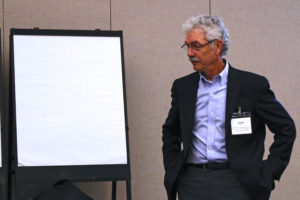The Health Innovation Team on April 13 hosted a telehealth education workshop called “Reimbursement to Value in Telehealth.” The discussion centered on informing medical practices on the use of telemedicine to benefit patients, insurance and providers alike. The workshop was the first of its kind to be hosted by Kansas City Digital Drive, and more than 30 medical professionals attended.
Among the speakers were Richelle Marting, an attorney in Overland Park, and David Voran, a current family practitioner and an avid supporter of telemedicine. The attendees learned how to advocate for telemedicine with insurance providers, how to code for telemedicine in the billing process and how to strategically provide telemedicine services for their patients.
David Voran started the day off with the history his own career and advocacy for telemedicine. Voran has always been a forward thinker, and when HIPPA was passed, he “jumped for joy” because he was certain that, as a result, medicine would have to shift to electronic medical records. Instead, he was disappointed when the transition progressed in the opposite direction. Over the course of his career, he’s had similar disappointments in the adoption of telemedicine and other medical practices, bute continues to be hopeful about telemedicine andplans to use it aspart-time income well into his own “retirement.”
“I’m trying to build a retirement business for myself in my neighborhood of 70 homes, you know there’s a lot of us doctors that like to play golf,” Voran said. “I thought that with all this CPC+, if we could just set up the clubhouse with large screens, and if a patient of physician X lived in my neighborhood, then I would go ahead and act as physician X and we could have coffee and I could do the chronic condition management in the clubhouse!”

David Voran listens to a question at Reimbursement to Value in Telehealth workshop on April 13, 2017. Photo by Katherine Hambrick
Voran is close to the end of his career but predicts he won’t ever truly “retire.” His optimistic picture of the future was made not only in the context of his own business, but also in the larger scope of improving health diagnostics.
“If we could have neighborhood retired doctors that could contribute occasionally in between rounds of golf, it would improve the pool of expertise greatly,” said Voran.
While Voran presented the possibilities of a partially remote practice, Richelle Marting gave concrete examples of how and where to use telemedicine in daily medical routine. Though many practices often see telehealth as an advanced way of treating patients, some treatment can already be billed under Medicare and Medicaid telehealth services. Services such as psychotherapy, nutrition services, office visits and diabetes management are among those that are able to be treated remotely and billed under telehealth.
Additional presentations and panels included speakers Morgan Waller, Director of Telemedicine Professional Services at Children’s Mercy Hospital, and Eve-Lynn Nelson, Director of KU Center for Telemedicine and Telehealth.
Among the interesting topics that emerged from the panel: flexibility in the workplace for telemedicine and bureaucracy-based issues in remote health services.
The panel idealized a world where doctors reduce their workload and stress by operating out of an office and their own home. They envisioned a neighborhood clinic in a local space, run by a trusted community member. In that space, the clinic might have a telemedicine desk or computer where residents could be treated or attend appointments. Voran sees the future of medical practice akin to banks, where customers initiate transactions and there are little overhead costs.
Finally, the panel agreed that telemedicine and medicine is generally hindered by privacy issues and bureaucracy. Even something as simple as doctor notes are handicapped when providers have to write them for an audience.
“The providers document to prevent litigation and to get reimbursed,” Waller said.“The patient getting something out of the note is the last of the consideration! And that’s our fault, that’s what we’ve done to them.”
To attend future conferences like this, or read more Kansas City health innovation news, make sure to sign up for our newsletter! Stay tuned for video of the conference speakers.
